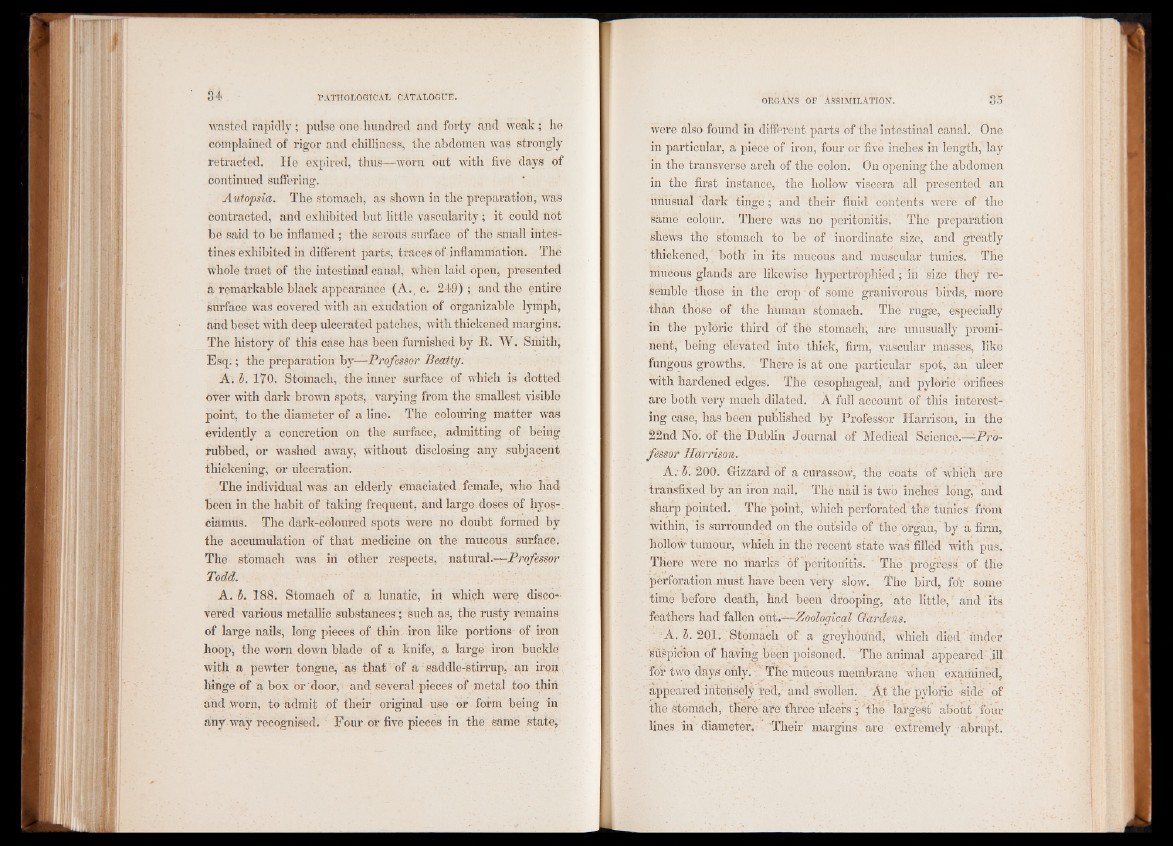
wasted rapidly; pulse one hundred and forty and weak; he
complained of rigor and chilliness, the abdomen was strongly
retracted. He expired, thus—worn out with five days of
continued suffering.
Autopsia. The stomach, as shown in the preparation, was
contracted, and exhibited but little vascularity; it could not
be said to be inflamed ; the serous surface of the small intestines
exhibited in different parts, traces of inflammation. The
whole tract of the intestinal canal, when laid open, presented
a remarkable black appearance (A., c. 249); and the entire
surface was covered with an exudation of organizable lymph,
and beset with deep ulcerated patches, with thickened margins.
The history of this case has been furnished by It. W. Smith,
Esq.; the preparation by—Professor Beatty.
A. b. 170. Stomach,, the inner surface of which is dotted
over with dark brown spots; varying from the smallest visible
point, to the diameter of a line. The colouring matter was
evidently a concretion on the surface, admitting of being
rubbed, or washed away, without disclosing any subjacent
thickening, or ulceration.
The individual was an elderly emaciated female, who had
been in the habit of taking frequent, and largo doses of hyos-
ciamus. The dark-coloured spots Were no doubt formed by
the accumulation of that medicine on the mucous surface.
The stomach was iii other respects, natural.-—Professor
Todd.
A. b. 188. Stomach of a lunatic, in which were discovered
various metallic substances ; such as, the rusty remains
of large nails, long pieces of thin iron like portions of- iron
hoop, the worn down blade of a knife, a large iron buckle
with a pewter tongue, as that of a saddle-stirrup, . art iron
lunge of a box or door, and several pieces of metal too thin
and Worn, to admit of their original use or form being in
ainy way recognised. Four or five pieces in the same state,
were also found in different parts of the intestinal canal. One
in particular, a piece of iron, four or five inches in length,' lay
in the transverse arch of the colon. On opening the abdomen
in the first instance, the hollow viscera all presented an
imusual 'dark tinge; and their fluid contents were of the
Samë colour. Théfe was no peritonitis. The preparation
shews the stomach to be of inordinate size, and greatly
thickéned, both in its mucous and muscular tunics. The
mucous glands are likewise hypertrophied; in size they resemble
those in the crop • of some granivorous birds, more
than those of the human stomach. The rugse, especially
in the pyloric third of the stomach; are unusually prominent,
being elevated into thick, firm, vascular masses, like
fungous growths. There is at one particular spot, an ulcer
with hardened edges. The oesophageal, and pyloric' orifices
are both very much dilated. A full account of this interesting
case, has been published by Professor Harrison, in the
22nd No. of the Dublin Journal of Medical Science.—-Professor
Harrison.
A. b. 200. Gizzard of a curassow5 the coats of which are
transfixed by an iron nail. The nail is two inches long, and
sharp pointed. The point, which perforated the tunics' from
within, is surrounded on the outside of the organ, by a firm,
hollow-tumour, which in thé recent state was filled With pus.
There were no marks óf peritonitis. ‘ The progress'' of the
perforation must have been very slow. The bird, for sometime'
before death, had been drooping, ate little,' and its
feathers had fallen out.-^-Zoological (hardens.
A. b. 20 1 . Stomach of a greyhound, which died, under
suspicion of having been poisoned. The animal appeared jll
for two days Onlyi- The mucous membrane when examined,
appeared intensely red, and swollen. At the pyloric side of
the stomach, thereare three ulcers j'th i largest about four
lines in diameter. 'Their' margins are extremely abrupt.